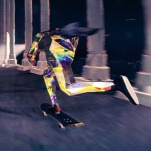Way back in the prehistoric-CGI days of 1993, one of the big
award-winners livening up animation festivals was "Devil's Mine Ride," a
first-person-POV motion simulator that sent viewers caroming through a
spectacularly detailed, disintegrating mine. There were a couple of negligible
framing scenes, but mostly, the short was about watching a wholly manufactured
world whiz by, full of stomach-churning veers and drops. Trouble was, the short
was all experiential; the memories barely outlasted the brief adrenaline rush.
The latest of many screen adaptations of Jules Verne's Journey To The Center
Of The Earth is "Devil's
Mine Ride" blown up to feature length: It even features a noticeably familiar
roller-coaster ride through a dangerous mine. Like its early predecessors, it's
a nominally fun trip, but it's tissue-thin and instantly forgettable.
Brendan Fraser, who's carved out a niche as an affable,
handsome goof whom directors can surround with CGI buddies and monsters, stars
as a geology wonk who's keeping the candle burning at the university lab of his
missing brother. Coincidentally, the news that the lab is being defunded and
shut down comes at the exact same time as a breakthrough in his brother's
research and a poorly timed 10-day visit from his brother's sullen young son (Bridge To Terabithia
star Josh Hutcherson), so Fraser reluctantly drags Hutcherson along on an
emergency trip to Iceland, where they and hired guide Anita Briem accidentally
plunge through a shaft into the Earth's core. There, they find a lost world
full of supposedly extinct creatures and giant CGI vistas. As with "Devil's
Mine," there are some vague nods toward plot and characterization, but mostly,
the film is all about the pretty and momentarily scary stuff they see along the
way.
The problem is, nothing about that pretty/scary stuff seems
particularly new. Journey tries to answer the inevitable question "What else you got?"
with crisp 3-D, but even that gimmick only goes so far. Director Eric Brevig
finds some fun ways to use the technology, like having two different characters
projectile-spit at the screen, but it's mostly used as 3-D has always been
used, for lunge-at-the-camera shocks. Given that Brevig is taking his first
turn in the director's chair after 20 years of helming special-effects teams on
everything from Michael Bay films to Men In Black to Captain Eo, it's no wonder that Journey is so focused on the shiny and
spectacular, and it's perfectly serviceable in that regard. But nothing about
it reaches beyond the instant the images flash by onscreen.








































